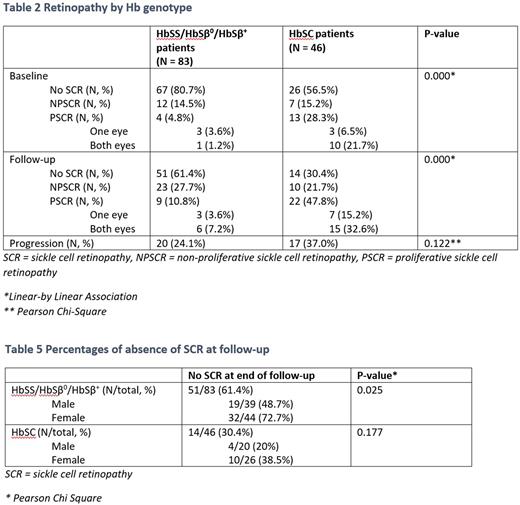Abstract
Background: Sickle cell disease (SCD) is characterized by chronic hemolysis and recurrent vaso-occlusion, resulting in tissue ischemia and organ damage. The retina is very sensitive to ischemic damage, which can result in sickle cell retinopathy (SCR). SCR can be divided into non-proliferative SCR (NPSCR) and proliferative SCR (PSCR). The proliferative form can be complicated by severe visual impairment due to vitreous haemorrhage and retinal detachment. With respect to retinopathy, different opinions exist about the necessity of regular screening. Knowledge of the natural history and risk factors for progression of SCR and subsequent complications is limited. Therefore, it would be helpful to determine the cumulative incidence of SCR in a large population of adult patients and to identify risk factors for progression and vision threatening complications.
Aims: The aim of our study is to describe the natural history of SCR in a systematically analysed cohort of patients with SCD and to identify risk factors for the development of PSCR.
Methods: In our retrospective cohort study, we recruited all patients with SCD (HbSS, HbSC, HbSβ0 and HbSβ+) attending the departments of Haematology and Ophthalmology of our tertiary academic hospital between 2006 and 2011. Patients lost to follow-up were excluded. Clinical, ophthalmologic and laboratory data were systematically collected and retrospectively analysed. Univariate and multivariate binary logistic regressions were used to identify associations between clinical and laboratory variables and progression to PSCR.
Results: 129 SCD patients were included with a median follow-up of 11 years (IQR = 8.5-12). The median age at the end of follow-up was 34 years (IQR = 28-45). HbSS/HbSβ0/HbSβ+ genotype was present in 64.3% (83/129) of the patients and HbSC genotype was present in 35.7% (46/129). Progression of SCR during follow-up was seen in 28.7% (37/129) of the patients. Male sex was the only predictor for progression of SCR (aOR: 2.535, 95% CI: 1.152-5.579, p = 0.021). Age (aOR: 1.073, 95% CI: 1.024-1.125, p = 0.003) and HbSC genotype (aOR: 35.796, 95% CI: 7.444-172.125, p <0.001) were associated with PSCR at end of follow-up. Hb level and microalbuminuria were no independent risk factors for PSCR or progression to PSCR (p > 0.05). Lack of any SCR at end of follow-up was associated with female sex (aOR: 3.440, 95% CI: 1.523-7.774, p = 0.003) and HbSS/HbSβ0/HbSβ+ genotype (aOR: 6.419, 95% CI: 2.352-17.519, p = <0.001).
Conclusion: Progression of SCR was seen in more than a quarter of the patients. Age and HbSC genotype were associated with progression to PSCR at end of follow-up. Female SCD patients and patients with HbSS/HbSβ0/HbSβ+ genotype were at significant lower risk of developing SCR than other patients. Given the high rate of progression of SCR, screening of SCR remains important, but differentiated strategies for screening and follow-up of SCR could be considered for low-risk or high-risk patients.
Disclosures
Nur:Novartis: Membership on an entity's Board of Directors or advisory committees, Research Funding, Speakers Bureau. Biemond:Modus Therapeutics: Membership on an entity's Board of Directors or advisory committees; BMS: Research Funding; Novo Nordisk: Membership on an entity's Board of Directors or advisory committees; Chiesi: Membership on an entity's Board of Directors or advisory committees; CSL Behring: Membership on an entity's Board of Directors or advisory committees; Celgene: Membership on an entity's Board of Directors or advisory committees; Bluebird Bio: Membership on an entity's Board of Directors or advisory committees; GBT: Research Funding; BMS: Research Funding; Celgene: Membership on an entity's Board of Directors or advisory committees; Novo Nordisk: Membership on an entity's Board of Directors or advisory committees; CSL Behring: Membership on an entity's Board of Directors or advisory committees; Chiesi: Membership on an entity's Board of Directors or advisory committees; Bluebird Bio: Membership on an entity's Board of Directors or advisory committees; GBT: Membership on an entity's Board of Directors or advisory committees, Research Funding; Sanquin: Research Funding; Novartis: Membership on an entity's Board of Directors or advisory committees, Research Funding.
Author notes
Asterisk with author names denotes non-ASH members.


This feature is available to Subscribers Only
Sign In or Create an Account Close Modal